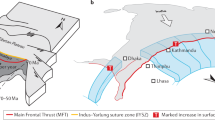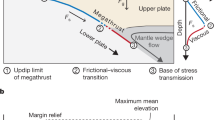Abstract
As an officer of the Survey of India, employed for many years in determining deflections of the plumbline and variations in the intensity of gravity, I was interested to find in the article which appeared under this heading in NATURE (No. 2261, vol. xc., February (27) reference to the hypothesis suggested in I 1904 by the Rev. O. Fisher as to the nature of mountain compensation, and the statement that this hypothesis goes far to explain the deflections of the plumb-line observed at the foot of the Himalayas and in the Gangetic plain. The article states that, according to Mr. Fisher's hypothesis, “the crust is of uniform density, the isostatic compensation being obtained by a variation in thickness,” and that, on this hypothesis, Mr. Fisher “finds that the attraction of the visible range combined with the negative attraction of the downward protuberance should give a northerly deflection of about 24″ at the foot of the hills, of about 2″ at sixty miles away, and a southerly deflection of about 2″ at the farther edge of the plains. These results appear to be in very fair accord with the observations....”
This is a preview of subscription content, access via your institution
Access options
Subscribe to this journal
Receive 51 print issues and online access
$199.00 per year
only $3.90 per issue
Buy this article
- Purchase on Springer Link
- Instant access to full article PDF
Prices may be subject to local taxes which are calculated during checkout
Similar content being viewed by others
Author information
Authors and Affiliations
Rights and permissions
About this article
Cite this article
COWIE, H. The Mountains and their Roots. Nature 91, 243–245 (1913). https://doi.org/10.1038/091243a0
Issue Date:
DOI: https://doi.org/10.1038/091243a0
Comments
By submitting a comment you agree to abide by our Terms and Community Guidelines. If you find something abusive or that does not comply with our terms or guidelines please flag it as inappropriate.



